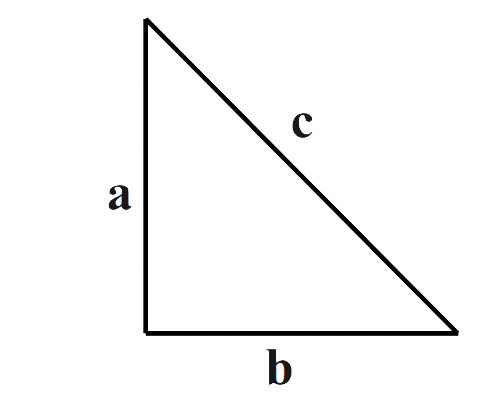
The magnitude of two vectors P and Q differ by 1. The magnitude of their resultant makes an angle of \[{{\tan }^{-1}}\left(\dfrac{3}{4} \right)\] with P. The angle between P and Q is:
A. \[45{}^\circ \]
B. \[0{}^\circ \]
C. \[180{}^\circ \]
D. \[90{}^\circ \]
Answer
551.4k+ views
Hint: In this question we have been asked to calculate the angle between vector P and vector Q. it is given that the magnitude of resultant vector makes an angle of \[{{\tan }^{-1}}\left( \dfrac{3}{4}\right)\] with vector P. Therefore, to solve this question, we shall use the triangle rule for vector to calculate the angle between vectors P and Q.
Formula used: -\[{{c}^{2}}={{a}^{2}}+{{b}^{2}}\]
Where,
C is the hypotenuse
A and B are opposite and adjacent sides.
Complete step-by-step solution:
It is given that the magnitude of resultant vector P makes an angle of \[{{\tan }^{-1}}\left(\dfrac{3}{4} \right)\].
This means that the ratio of the two given vectors is \[\dfrac{3}{4}\]
Therefore,
We know that,
\[\tan (x)=\dfrac{opposite}{adjacent}=\dfrac{P}{Q}\]
Now, by Pythagoras theorem,

We know,
\[{{c}^{2}}={{a}^{2}}+{{b}^{2}}\]
After substituting properly,
\[R=\sqrt{{{3}^{2}}+{{4}^{2}}}\]
Therefore,
\[R=5\] …………………. (1)
Now, to calculate the angle between vector P and vector Q.
We know from triangle rule of vectors
\[R=\sqrt{{{P}^{2}}+{{Q}^{2}}+2PQ\cos \theta }\]
After substituting values and from (1)
We get,
\[{{R}^{2}}={{3}^{2}}+{{4}^{2}}+2\times 3\times 4\cos \theta \]
On solving,
We get
\[25=25+24\cos \theta \]
Therefore,
\[\theta ={{\cos }^{-1}}(0)\]
Therefore,
\[\theta =90{}^\circ \]
Therefore, the correct answer is option D.
Note: In mathematics, the Pythagorean theorem, also known as Pythagoras's theorem, is a fundamental relation in Euclidean geometry among the three sides of a right triangle. It states that the area of the square whose side is the hypotenuse is equal to the sum of the areas of the squares on the other two sides. In Pythagorean theorem, the hypotenuse is given by equation,
\[{{c}^{2}}={{a}^{2}}+{{b}^{2}}\].
Formula used: -\[{{c}^{2}}={{a}^{2}}+{{b}^{2}}\]
Where,
C is the hypotenuse
A and B are opposite and adjacent sides.
Complete step-by-step solution:
It is given that the magnitude of resultant vector P makes an angle of \[{{\tan }^{-1}}\left(\dfrac{3}{4} \right)\].
This means that the ratio of the two given vectors is \[\dfrac{3}{4}\]
Therefore,
We know that,
\[\tan (x)=\dfrac{opposite}{adjacent}=\dfrac{P}{Q}\]
Now, by Pythagoras theorem,

We know,
\[{{c}^{2}}={{a}^{2}}+{{b}^{2}}\]
After substituting properly,
\[R=\sqrt{{{3}^{2}}+{{4}^{2}}}\]
Therefore,
\[R=5\] …………………. (1)
Now, to calculate the angle between vector P and vector Q.
We know from triangle rule of vectors
\[R=\sqrt{{{P}^{2}}+{{Q}^{2}}+2PQ\cos \theta }\]
After substituting values and from (1)
We get,
\[{{R}^{2}}={{3}^{2}}+{{4}^{2}}+2\times 3\times 4\cos \theta \]
On solving,
We get
\[25=25+24\cos \theta \]
Therefore,
\[\theta ={{\cos }^{-1}}(0)\]
Therefore,
\[\theta =90{}^\circ \]
Therefore, the correct answer is option D.
Note: In mathematics, the Pythagorean theorem, also known as Pythagoras's theorem, is a fundamental relation in Euclidean geometry among the three sides of a right triangle. It states that the area of the square whose side is the hypotenuse is equal to the sum of the areas of the squares on the other two sides. In Pythagorean theorem, the hypotenuse is given by equation,
\[{{c}^{2}}={{a}^{2}}+{{b}^{2}}\].
Recently Updated Pages
Why are manures considered better than fertilizers class 11 biology CBSE

Find the coordinates of the midpoint of the line segment class 11 maths CBSE

Distinguish between static friction limiting friction class 11 physics CBSE

The Chairman of the constituent Assembly was A Jawaharlal class 11 social science CBSE

The first National Commission on Labour NCL submitted class 11 social science CBSE

Number of all subshell of n + l 7 is A 4 B 5 C 6 D class 11 chemistry CBSE

Trending doubts
What is meant by exothermic and endothermic reactions class 11 chemistry CBSE

10 examples of friction in our daily life

One Metric ton is equal to kg A 10000 B 1000 C 100 class 11 physics CBSE

1 Quintal is equal to a 110 kg b 10 kg c 100kg d 1000 class 11 physics CBSE

Difference Between Prokaryotic Cells and Eukaryotic Cells

What are Quantum numbers Explain the quantum number class 11 chemistry CBSE




